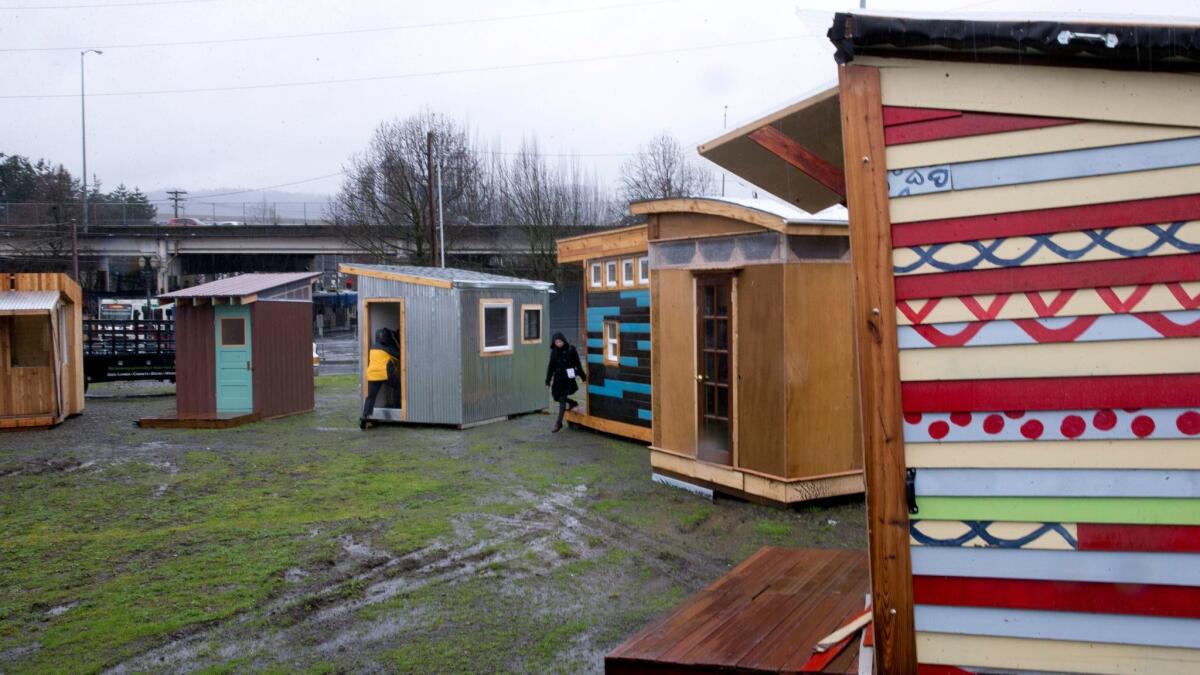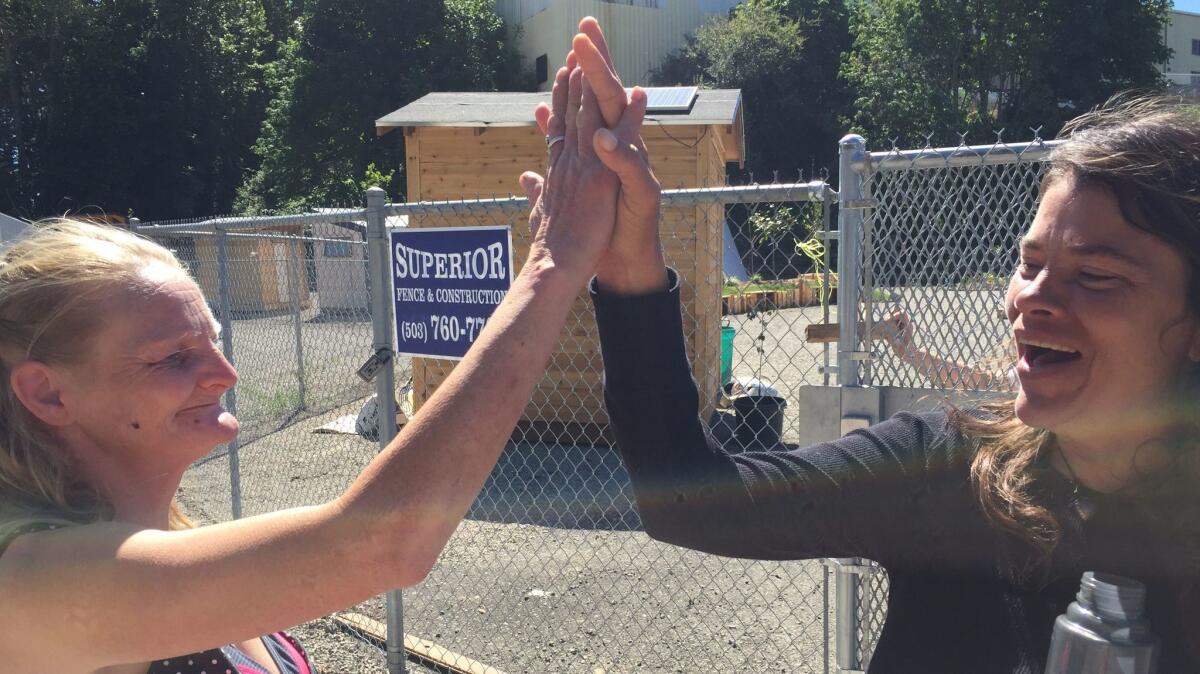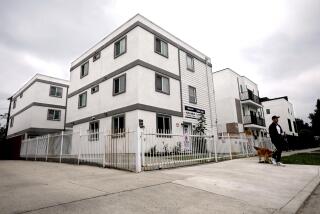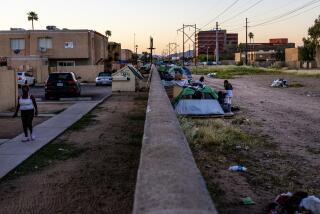In Portland, a fitful start to a new way to help the homeless: A village of tiny houses

- Share via
Reporting from PORTLAND, ORE. — On June 10, 14 residents moved into 14 tiny houses in Portland’s first government-supported homeless village.
Just 18 days later, two residents were gone.
One was evicted for “highly disruptive” behavior, said the director of the nonprofit that co-manages Kenton Women’s Village. Another voluntarily returned to the streets to get away from what she described as verbal abuse and constant conflict.
But another resident, Jewel Ramirez, has decorated her tiny house with photos of her family. “I love it,” she said.
The contrasting reactions reflect the problems — and the promise — of a project that charts new territory in Portland, marrying public funding and nonprofit oversight with a type of shelter that was born out of protest. Homeless villages have popped up on their own in Portland and in other cities in the past, and they’ve been run by their own quasi-governments.
Kenton Women’s Village, however, is part of a grand plan to fight homelessness and has been surrounded by buzz and the support of top local officials, including Mayor Ted Wheeler and Multnomah County Chairwoman Deborah Kafoury.
Executive Director Richard Birkel of Catholic Charities of Oregon, which co-manages the village, said the early struggles reflect the village’s “hybrid” model, one that he said has “never been done before.”
“There are dominance issues” among residents, Birkel said. “Who’s going to rise to the top; who’s going to be the alpha? We’re monitoring that carefully.”
Already, the agency is adding a second village manager position and a nighttime guard, upgrading mental health services and changing the village’s physical layout to add privacy.
Birkel acknowledged missteps. In retrospect, the nonprofit should not have declared an initial 30-day period of “rest and recovery” before offering some services, he said. “Some women were ready and needed intensive services from Day One, and we should have been providing that.”
The village’s “sleeping pods,” which look like little cabins, have no heat, air conditioning, plumbing or wired electricity, but they do have lockable doors and solar panels to power a cellphone. Modular containers serve as shared kitchens and bathrooms. Trucks pass in front of a locked 6-foot fence, and the howls of cars at a nearby racetrack alternate with horns blasting from passing freight trains.
Federal and state cuts to social services and affordable housing programs, combined with Portland’s growing homeless population — up 9.9% since 2015 — have spurred officials to look more closely at the village model. Other cities, such as San Jose and Seattle, either have homeless villages or are considering them.
The pods afford autonomy and privacy for less money than a traditional shelter, advocates say. “If you don’t like somebody, you can go in your own pod,” Ramirez said.
“It is very democratic,” she said. “You get into your routines, you get to know each other and their boundaries. All in all, I think it is a very positive thing for me.”
Ramirez is diabetic and nearly deaf, surviving on a $735 monthly Social Security payment. Sixty-one percent of the county’s homeless population — 4,177 people by a recent count — report living with disabilities such as a mental illness, chronic physical condition or addiction.
Two of Ramirez’s fellow villagers, April Langworthy and Lynette Ingalls, shared a high-five last month to celebrate Ingalls’ three months of sobriety.
“I quit doing dope to get in here,” Ingalls said. Her drug of choice, she said, was methamphetamine.

The recent count, released June 19, found the region’s homeless population is getting older and is disproportionately made up of people of color — dynamics reflected at Kenton Women’s Village. Ten of the village’s original 14 women are 50 or older, and four are women of color, Catholic Charities staff said.
The hard times are harder to quantify. Ramirez was 6 when she was taken away from her mother. One of Langworthy’s two adult children died serving in Afghanistan.
As Langworthy and Ingalls talked in the parking lot outside the village’s fence, they were interrupted by other women from the village. A shouting match ensued.
“Community living is just tough,” Langworthy said.
Disabilities such as mental illness and addiction probably contributed to the village’s struggles — Birkel called disability a “huge” factor.
The chaos was bad enough that a homeless man living under a tarp in the parking lot noticed it. The village is “pretty cool,” said Noah Haskett, 30, “but every time I come around there’s always conflict with the women.”
The woman who returned to the streets said two residents used racial slurs against her, more than once.
Birkel said that he has “no knowledge” of the use of racial slurs at the village, and that his organization doesn’t accept such behavior. Still, he said, “I’m not sure what staff could have done, except point out that it’s unacceptable.”
Such ambiguity may be related to tensions in the village’s “hybrid” model.
“A purist might say, ‘This isn’t really self-governing,’ and I would say, ‘That’s correct,’” Birkel said. “We’re trying to use some of the brilliant elements from self-governance, but we can’t replicate that correctly.”
The city of Portland and Multnomah County have budgeted about $350,000 for the village’s first year, Denis Theriault of the Joint Office of Homeless Services said. About $218,000 of that is going to Catholic Charities, a county document shows.
Ibrahim Mubarak, co-founder of two other homeless villages in the city, Dignity Village and Right 2 Dream Too, said government and big nonprofits don’t understand grass-roots self-governance.
“If the city starts it, it’s not going to be successful, unless they have the houseless people leading it, because they don’t understand living on the street,” Mubarak said.
Kenton Women’s Village is meant to be a way station, not a final destination. The goal is to help residents find permanent housing, Birkel said, which differentiates it from Portland’s other villages. Indeed, residents sometimes do languish at homeless villages: At Dignity Village, three residents said in interviews that they have lived there seven to 10 years.
“People aren’t going to be here five years,” Birkel said. “They’re not even going to be here 14 months.”
The village’s sponsors hope a community will develop, and there are signs that is indeed happening. Birkel said women are working together to paint their pods and plant community gardens. Seven residents were paid $20 apiece to create the Kenton Women’s Village Water Station at the Portland Marathon; afterward, each put half her take toward a first-ever village barbecue.
The group also rallied around a woman who recently lost her husband.
“To watch the community respond to her and her grief was amazing,” Birkel said. “I think these are early signs that the community is beginning to gel.”
Schmid is a special correspondent.
ALSO
One size doesn’t fit all: In Salt Lake City, a community rethinks how it helps its homeless
Denver finds a simple and innovative way to help the homeless — wash their clothes
Portland’s longtime homeless camp is moving, but underlying problems persist
More to Read
Sign up for Essential California
The most important California stories and recommendations in your inbox every morning.
You may occasionally receive promotional content from the Los Angeles Times.










